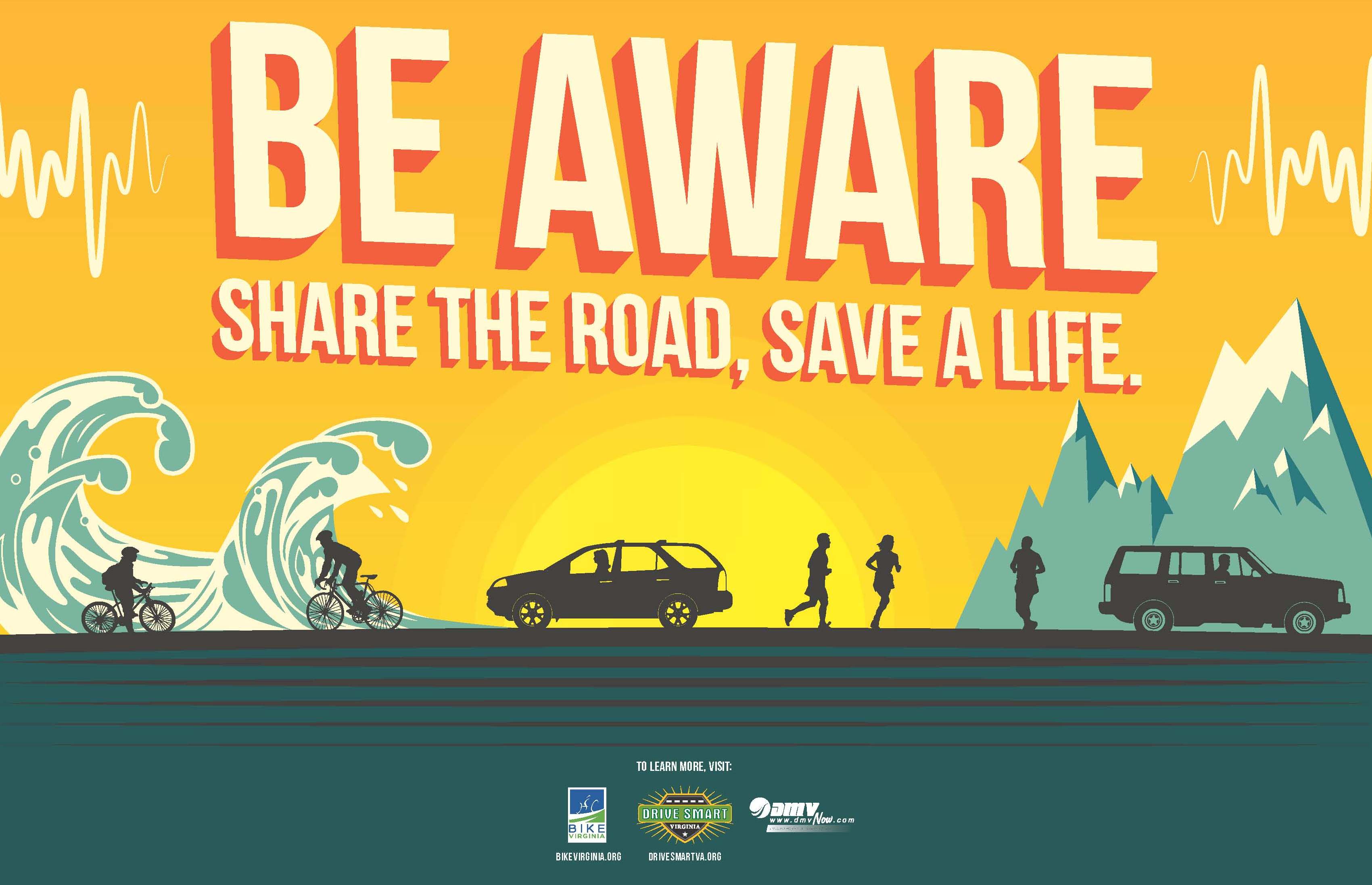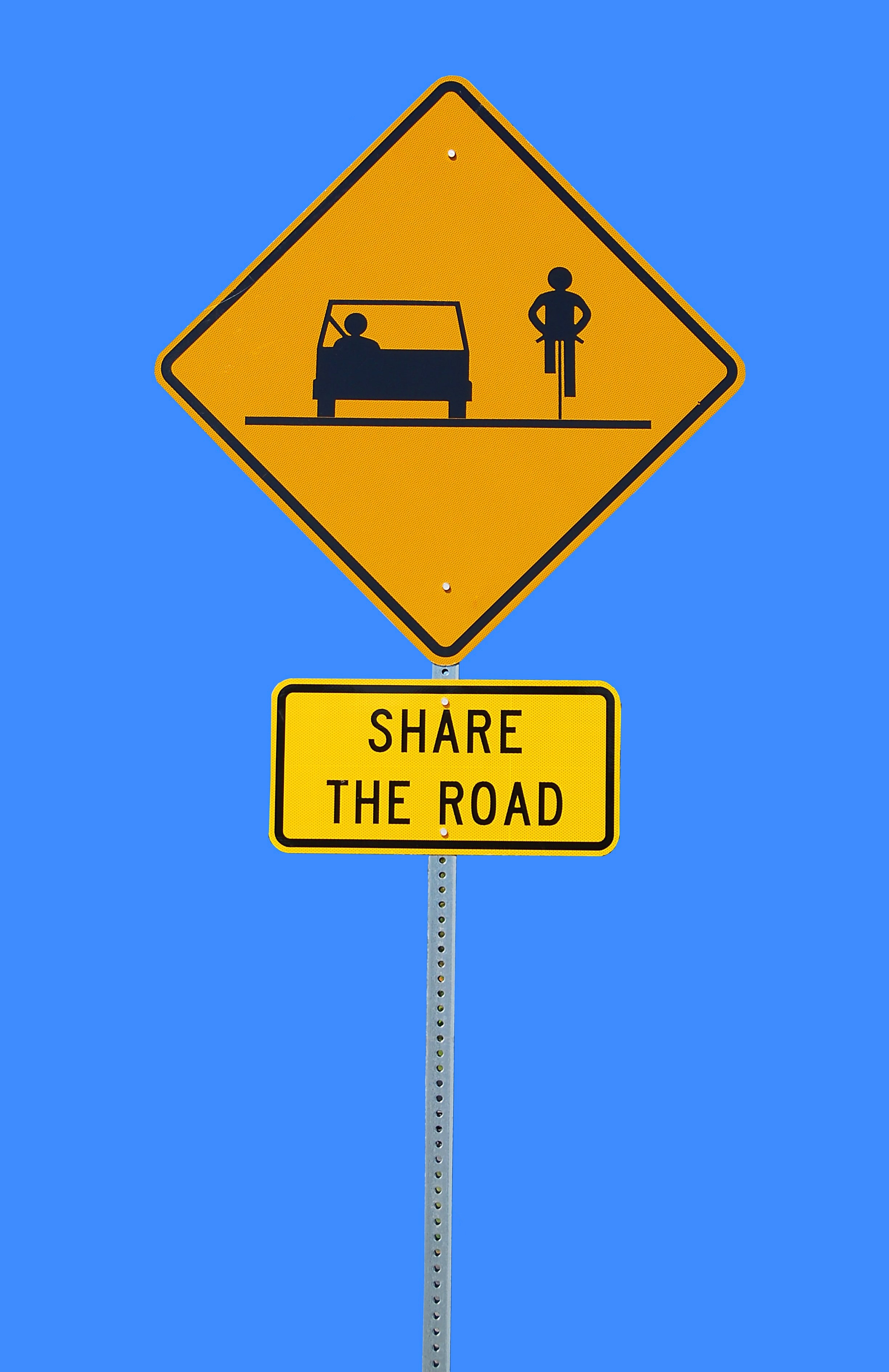Sharing the road with cyclists and pedestrians is challenging for most drivers, especially when there are so many distractions facing today’s drivers. The bevy of gadgets available are often the biggest culprits to distracted driving, but increased stress, sleep deprivation, roadway construction projects and heavy traffic play their part in distracting drivers as well.
Reducing distractions and being more alert are the best ways to make everyone safer on the road.
Be aware. Share the Road, Save a Life
Virginia Bicyclist and Pedestrian Awareness Week (BPAW) is September 9 – 15. This year’s theme is: Be Aware. Share The Road, Save A Life.
 DRIVE SMART Virginia reports that 2011 was a difficult year for bicyclist and pedestrian safety in Virginia.
DRIVE SMART Virginia reports that 2011 was a difficult year for bicyclist and pedestrian safety in Virginia.
- 81 pedestrians and bicyclists were killed
- 730 bicyclists were injured
- 1,712 pedestrians were injured
During the fourth year of Virginia Bicyclist and Pedestrian Awareness Week (BPAW), DRIVE SMART Virginia wants drivers to focus on the road and leave distractions behind. Anything that takes your eyes or mind off the road can make your trip a dangerous one. Bicyclists and pedestrians have responsibilities too, like wearing reflective clothing and obeying traffic laws. While bicyclists should ride with traffic, runners and walkers should move against it.
DRIVE SMART Virginia’s web site is loaded with information on avoiding distractions, tips for driving smarter as well as educational tools for employees. Also you can find and download the DRIVE SMART Virginia toolkit and order brochures and posters which will outline Virginia BPAW in more detail.
Virginia performs well against national cyclist fatality averages
The latest available statistics from the National Highway Traffic Safety Administration showed that in 2009, 630 pedalcyclists (includes bicyclists; riders of two-wheel, non-motorized vehicles; tricyclists and unicyclists) were killed and an additional 51,000 were injured in motor vehicle traffic crashes. Luckily for us, Virginia is below the national average for pedalcyclist fatalities with only 11 fatalities in 2009. Florida had the highest number of fatalities with more than 100.
National averages show that 70 percent of all pedalcyclist fatalities occur in urban areas, 72 percent occur during daytime hours (4 a.m. to 8 p.m.), and though the average age of a pedalcyclist fatality is 39 (from 2000 to 2009), it is the younger pedalcyclists (under the age of 16 years) who are the most vulnerable. The actions of these younger riders can be hard to predict – even when they are riding on the sidewalk they can easily lose control and veer into the street.
Cyclist safety concerns
Street hazards can also cause problems for bicycle riders. Bicycle tires may become caught in the gratings of storm drains causing the cyclist to fall, or the cyclist may try to avoid a drain by swerving around it. Cross-country cyclists may be more predictable than younger riders, but they significantly impede traffic and can be a challenge to even the most cautious of drivers. These cyclists seem to prefer town and country roads where drivers must slow down and patiently wait for a safe opportunity to pass.
Taking precautions to avoid an accident with a cyclist
- Watch out for cross-country cyclists and maintain your following distance.
- Expect the unexpected. Anticipate the actions of cyclists.
- Use caution when passing cyclists.
- Watch for cyclists as you make a turn.
- Check sidewalks for cyclists as you look left-right-left at intersections.
Pedestrians and intersections
The most hazardous 100 feet of any road is when it crosses another road. One reason for this is that judging speed and distance is a serious challenge for pedestrians and motorists.
A pedestrian may see a vehicle approaching an intersection at a slow speed and misjudge the crossing time/distance. A driver approaching an intersection may see a pedestrian halfway across the street and think it is safe to continue through the intersection without significantly slowing down.
These situations illustrate accidents waiting to happen – under normal circumstances. Since it is easier for the driver than for a pedestrian to judge the flow of traffic, the space between vehicles and the width of a street, the primary responsibility for avoiding pedestrian accidents falls on the driver.
Additional hazards or unusual situations to watch for at intersections:
- Pedestrians may assume the right-of-way.
- A person may still be crossing the intersection when the light changes.
- Pedestrians may stumble/trip and fall in your path of travel.
- Senior citizens may take longer to cross a street.
- Children may dash into the street at the last possible moment.
Merge your defensive driving skills and safety knowledge to avoid accidents at intersections:
- Slow down and position your foot over the brake so you will be better prepared to stop.
- Scan the intersection; look left-right-left.
- Obey traffic signs and signals.
- Maintain an adequate following distance considering vehicle type, size, and weather conditions.
- If you are going to turn at an intersection, signal your intentions at least 100 feet prior to the turn.
- Establish eye contact when you have to depend on others to stay put.
Pedestrian fatality statistics
Nationally, in 2009, the National Highway Traffic Safety Administration reported that 4,092 pedestrians were killed and an estimated 59,000 were injured in traffic crashes. More than two-thirds (69 percent) of pedestrians killed in 2009 were males, and even more startling, alcohol involvement – either for the driver or the pedestrian – was reported in 48 percent of all pedestrian fatalities. Again, Virginia is well under the national average with only 73 pedestrian fatalities. California and Florida have the highest number of pedestrian fatalities with over 450 each.
Richmond Ambulance Authority goes viral
The Richmond Ambulance Authority (RAA), VML Insurance Programs’ member since 2007, unveiled the national launch of its ‘Crossing Alert’ campaign rap public service announcement on YouTube to get pedestrians in Richmond, and throughout the nation, to stop, look and listen before crossing the street.
[youtube=http://youtu.be/lyR_x-irOf0]
This is part of the RAA’s ‘Crossing Alert’ campaign.
More information on driving safety can be found in the VML Insurance Programs Multimedia Library, available online for eligible members.
VMLIP offers more than just coverage. We are partners in risk management. How does your insurer stack up? Having all lines of coverage with VMLIP ensures that your organization is receiving comprehensive coverage and a wide variety of value-added services tailored to Virginia’s local governmental entities. Call for a quote today: (800) 963-6800. For more information on VMLIP visit: www.vrsa.us or follow us on Facebook.
** VMLIP blog postings are offered for VMLIP members to utilize in strengthening their risk management efforts. See copyright information for clarification on sharing this information.



